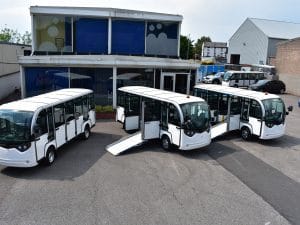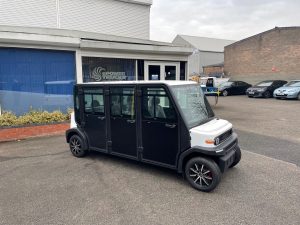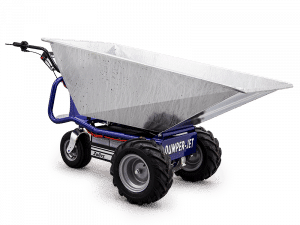Zoos
-

EP 14 Passenger Bus Multi Passenger Electric Vehicle
EP 14 Passenger Bus Multi Passenger Electric Vehicle
- Power: Electric | 72 Volt
- Carrying Capacity: 14 people
- Range: 56 – 74 miles
- Speed: 18 mph
- Climbing Ability: 18%
-

EP 14-S Passenger Bus Multi Passenger Electric Vehicle
EP 14-S Passenger Bus Multi Passenger Electric Vehicle
- Power: Electric | 72 Volt
- Carrying Capacity: 14 people
- Range: 56 – 74 miles
- Speed: 18 mph
- Climbing Ability: 18%
-

EP AMP 6 Seat Electric Vehicle
EP AMP 6 Seat Electric Vehicle
- Power: Electric | 60 Volt
- Carrying Capacity: 6 people
- Range: 56 miles
- Speed: 18 mph
- Climbing Ability: 15%
-

EP AMP 4 Seat Electric Vehicle
EP AMP 4 Seat Electric Vehicle
- Power: Electric | 60 Volt
- Carrying Capacity: 4 people
- Turning Radius: 5.6m
- Speed: 25 mph
- Climbing Ability: 20%
-

EP 6 (4+2) Multi Passenger Electric Vehicle
EP 6 (4+2) Multi Passenger Electric Vehicle
- Power: Electric | 48 Volt
- Carrying Capacity: 6 people
- Range: 56 miles
- Speed: 15 mph
- Climbing Ability: 20%
-

EP 4 Multi Passenger Electric Vehicle
EP 4 Multi Passenger Electric Vehicle
- Power: Electric | 48 Volt
- Carrying Capacity: 4 people
- Range: 62 miles
- Speed: 15 mph
- Climbing Ability: 25%
-

EP 4 (2+2) Multi Passenger Electric Vehicle
EP 4 (2+2) Multi Passenger Electric Vehicle
- Power: Electric | 48 Volt
- Carrying Capacity: 4 people
- Range: 62 miles
- Speed: 15mph
- Climbing Ability: 25%
Common uses for Zoos
The adoption of electric utility trucks and wheelbarrows presents an opportunity for zoos to serve as educational hubs, showcasing innovative solutions for environmental challenges. Visitors, especially younger generations, can learn about the importance of renewable energy and the role each individual and institution plays in mitigating climate change. It’s not just about transportation; it’s about inspiring change and fostering a deeper connection between humans and the natural world.
Furthermore, by leading the way in sustainable practices, zoos can set an example for other industries, demonstrating that prioritising environmental responsibility is both achievable and beneficial. From reducing air and noise pollution within the zoo premises to minimising the overall ecological footprint of operations, the benefits extend far beyond the confines of the zoo gates.


